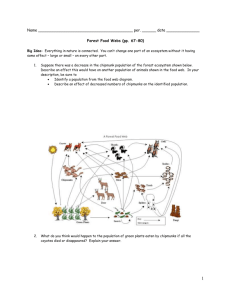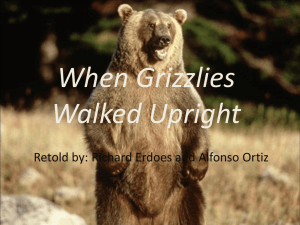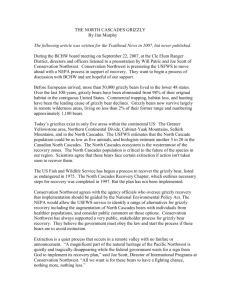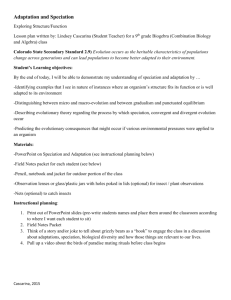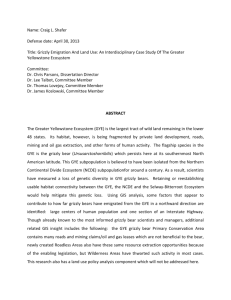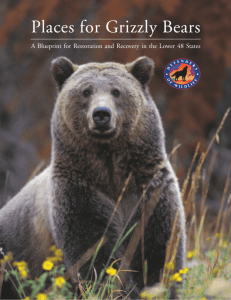Keys and Webs
advertisement
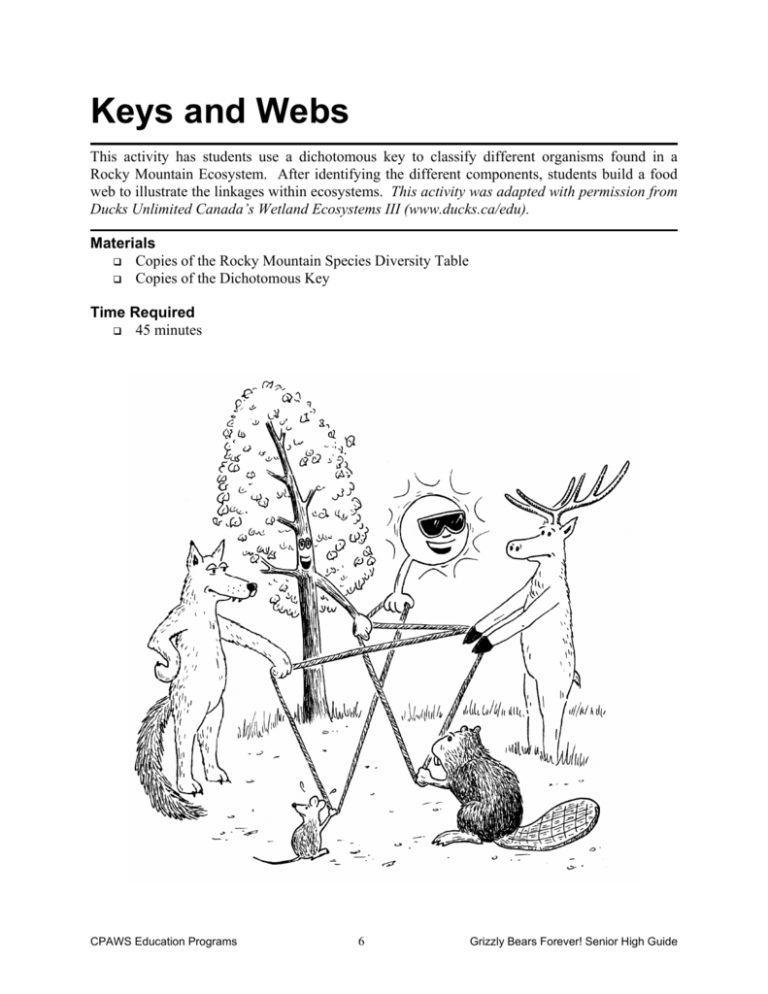
Keys and Webs This activity has students use a dichotomous key to classify different organisms found in a Rocky Mountain Ecosystem. After identifying the different components, students build a food web to illustrate the linkages within ecosystems. This activity was adapted with permission from Ducks Unlimited Canada’s Wetland Ecosystems III (www.ducks.ca/edu). Materials Copies of the Rocky Mountain Species Diversity Table Copies of the Dichotomous Key Time Required 45 minutes CPAWS Education Programs 6 Grizzly Bears Forever! Senior High Guide Instructions for the Teacher 1. Review the following definitions and keywords with students. Key Words carnivore: an animal that eats meat (e.g. a cougar) herbivore: an animal that eats plants (e.g. deer) omnivore: an animal that eats both animal and vegetable matter (e.g. grizzly bear) decomposer: an organism that breaks down organic matter (e.g. worm) predator: an animal that hunts, captures and kills another animal (the prey) for food prey: an animal that is a source of food for a predator producer/autotroph: an organism that makes its own food (e.g. green plant) heterotroph: a consumer organisms that cannot produce its own food and must rely on eating other organisms to meet its energy requirements consumer: an organism that feeds upon those below it in a food chain (e.g. herbivores that eat grass are consumers) primary consumer: herbivores that feed upon green plants or producers secondary consumer: carnivores or omnivores that feed upon herbivores tertiary consumer: carnivore that feeds on other carnivores food web: a complex system of interdependent food chains in a given ecosystem Law of Conservation of Energy: during a physical or chemical change energy is neither created nor destroyed, but may be changed in form and moved from place to place 2. Hand out the Rocky Mountain Species Diversity Table and Dichotomous Key. Review with your students how to use a dichotomous key. Keys have been developed by biologists to help others identify unknown organisms. As new species are discovered, their taxonomy must be developed using existing keys modified to include them. A dichotomous key is a simple chart that enables observers to identify and isolate the name of a specific item from a larger group of items, based on a series of either/or choices. 3. Review with students what a food web is. Ecosystems are characterized by their energy and matter exchange, which can be explained or illustrated using food chains, webs, or energy pyramids. In this exercize, students will create a food web from the species descriptions in the Diversity Table. 4. Discussion: After the students have identified the scientific names and drawn their food webs, examine the interrelatedness of ecosystems. Ask students to consider what might happen if a component of the ecosystem was removed. For example, if a large development is created in a wildlife corridor, there may be too many humans and infrastructure to allow large carnivores to remain. If the large carnivores (wolf, bear, cougar) are removed from the web of life, many other species will be affected: buffaloberries and other plants would not get distributed or fertilized; rodent and ungulate populations may not be kept in check and they could destroy their food sources and habitat, which in turn would affect numerous other species. Emphasize two points: CPAWS Education Programs 7 Grizzly Bears Forever! Senior High Guide Recent studies show that carnivores are far more important than previously thought. Their presence or absence will actually dictate how healthy the entire ecosystem is. This is known as the ‘top down’ or regulatory effect. Humans usually understand only a small amount of what actually goes on in an ecosystem: the relationships and interdependencies are too complex. This often makes our attempts to manage ecosystems unsuccessful or cause more damage than intended. Biologists and members of the environmental community have often asked decision-makers to use the precautionary principle. In the face of uncertainties, it is better to be conservative in decision-making and take precautions to avoid unnecessary environmental damage. 5. For further extension, give your students a species and ask them to identify it as a primary, secondary or tertiary consumer (e.g. long-tailed salamander = secondary consumer). Biology 30 Extensions: Review with your students the following terms: Intraspecific competition: competition between members of the same species for limited resources, such as food, water or space Interspecific competition: competition between members of different species Commensalism: an interaction between two species that benefits one species, while the other is not affected Mutualism: a mutually beneficial relationship between two species Parasitism: a relationship that benefits one species, but harms the other After developing the food web with students, ask them to describe the relationships between any linkages. Some examples: Canada buffaloberry – grizzly bear: mutualism (berries get distributed and fertilized) Grizzly bear – grizzly bear: intraspecific competition (for food in the harsh rockies) Hoary marmot – water vole: interspecific competition (for willow shrubs) Willow shrubs – lichens that grow on them: commensalism (no harm to willows) Wood ticks – moose: parasitism (tick outbreaks can harm moose populations) CPAWS Education Programs 8 Grizzly Bears Forever! Senior High Guide Student Activity Rocky Mountain Organisms The following is a list of a few organisms found in the Rocky Mountain Ecosystem. Using the dichotomous key on the next page, identify the animals using correct species and genus names. Note that in this key, genus and species names are in italics. The genus name is capitalized and the species name is not. When you have identified the scientific name of each organism, use an underline to indicate italics (i.e. Ursus arctos may be written Ursus arctos). COMMON NAME SCIENTIFIC NAME Mountain bluebird – These relatives of the robin are bright blue and can be found nesting in woodpecker cavities or nest boxes throughout the mountains. They may swoop to eat flying insects, or forage on the ground for beetles, ants and other terrestrial invertebrates. Hoary marmot – This marmot relies on sleeping to survive the harsh alpine environment – it hibernates for up to 9 months. This “whistler” feeds on grasses, sedges and herbs like yellow glacier-lily. These large, furry rodents run into their burrows to escape their predators, which include grizzly bears and golden eagles. Long-tailed salamander – These secretive amphibians feed on invertebrates under logs and rocks. As tadpoles, they are preyed upon by waterfowl; as adults, they are preyed upon by weasels and red-tailed hawks. Red-tailed hawk – The distinct “kieeeeaaarrr” call of this raptor can be heard throughout Alberta and on many movie soundtracks. Identified by their rusty-red tails, they dive to capture mice, voles, birds and amphibians. Yellow glacier-lily – One of the first flowers to bloom in early spring, the glacier lily’s bright yellow flowers have 6 petals and grow from a bulb in the ground. Bears and rodents eat the nutritious roots, while deer and sheep graze on the seed pods. Moose – The largest member of the deer family in North America, the moose is well-adapted to its environment: long legs allow it walk over forest debris and through deep snows, and its big bulbous nose and lips hold willow twigs in place so the lower incisors can rip them off. Grizzly bears, cougar and wolverine prey upon moose calves. Only the bulls (males) grow antlers. Wolverine – Wolverines are extremely sensitive to human disturbance and their populations have declined across North America. These elusive weasels are highly predatory and hunt for birds, rodents and even large mammals like moose. These 5-toed carnivores look like a small bear with a long bushy tail. Mallard duck – Found across Alberta, these dabbling ducks feed on seeds, aquatic invertebrates and larval amphibians at the surface of the water, tipping only their head in, rather than diving to deeper depths. Mallards are frequently hunted by humans and other predators like coyotes. Willow shrubs – There are many types of willows that dot the Alberta landscape. Their woody vegetation is an important food source for ungulates (hoofed mammals) and rodents alike. Willows are also important for humans: willow bark contains a compound that is used in Aspirin. Seeds are hairy capsules (i.e. not fleshy). CPAWS Education Programs 9 Grizzly Bears Forever! Senior High Guide COMMON NAME SCIENTIFIC NAME Lynx – One of three wild cats found in our mountains, the lynx is identified by the long black tufts of fur protruding from its ears. Its primary prey is the snowshoe hare. Wild cats have four toes with retractable claws. Snowshoe hare – These animals are found almost anywhere there is dense shrub in the Rockies. They feed primarily on grasses and brush, including the buds, twigs and bark of willows. These hares are often mistakenly called rabbits. Grizzly bear – an emblem of the wilderness, grizzlies require large home ranges for finding food and surviving. 80% of this bear’s diet comes from vegetation, including Canada buffaloberry or northern sweet-vetch. With their long 5-toed claws they will dig up ground squirrel burrows or pull apart decaying logs to eat ants. They will follow the smell of and eat rotting carrion up to 16 km away and occasionally hunt and kill young hoofed animals like moose or bighorn sheep. Their predators include other grizzlies, wolves, cougars and humans. Gray wolf – resembling a long-legged German shepherd with long large paws, the gray wolf can actually vary in colour (coal black to creamy white). Wolves are designed to eat large herbivores like bighorn sheep. Due to human hunting and habitat changes, wolf populations have declined across North America. Bighorn sheep – While both the females and males have horns throughout their lives, it is the ram’s curl that is most recognized. Bighorns feed on nonwoody plants (glacier lily) and grasses on alpine meadows and rocky slopes. Newborn lambs become prey for grizzlies, cougar and eagles. Northern sweet-vetch – Found on moist open slopes, these pink-flowered plants are members of the pea family (5 unequal petals). Sweet-vetch roots were widely used by native people for food. Grizzly bears will dig up the roots of sweet-vetch for food. Canada buffaloberry – Also called soapberry, the fleshy berries from this woody shrub are an important food source for grizzly bears in the Rockies. Grizzlies will eat up to 200,000 red buffaloberries per day! Wood Ant – There are at least 21 species of wood ants in Alberta that live in ant hills. Wood ants can bite when provoked leaving a stinging sensation from the formic acid stored in their abdomens. These invertebrates play an important role in pollinating flowers, distributing seeds and assisting in decomposing plant matter. Water Vole – Hikers may spot the small water vole hanging out by streams and creeks. The mouse-like vole’s tail can be almost 10 cm long. These rodents feast on various plants and roots, including willows and glacier lilies. CPAWS Education Programs 10 Grizzly Bears Forever! Senior High Guide Student Activity Rocky Mountain Organisms – Dichotomous Key 10. a) rodent (yellow upper and lower incisors) (go to 11) b) not rodent (go to 12) 1. a) autotroph (go to 2) b) heterotroph (go to 5) 2. a) mainly woody stem or shrub-like (go to 3) b) not woody, herbaceous stem (go to 4) 11. a) mouse-sized………Microtis richardsoni b) larger than mouse-sized………Marmota caligata 3. a) fruits are fleshy…………Shepherdia canadensis b) fruits not fleshy…………Salix spp. 4. a) member of the pea family, 5 unequal petals …………Hedysarum boreale b) member of the lily family, petals in 3’s or 6’s…………Erythoronium grandiflorum 12. a) hopping or jumping locomotion………Lepus americanus b) not hopping or jumping locomotion (go to 13) 13. a) carnivore (go to 14) b) herbivore (go to 17) 5. a) invertebrate (no backbone)…………Formica spp. b) vertebrate (backbone) (go to 6) 14. a) four-toed mammal (go to 15) b) five-toed mammal (go to 16) 6. a) flying (go to 7) b) not flying (go to 9) 15. a) retractable claws………Lynx canadensis b) non-retractable claws………Canis lupus 7. a) web footed, water living………Anas 16. a) tail small and inconspicuous…Ursus arctos b) long, bushy tail………Gulo gulo platyrhynchos b) not web footed, not water living (go to 8) 8. a) carnivorous…………Buteo jamaicensis b) insectivorous…………Sialia currucoides 17. a) both males and females have horns………Ovis canadensis b) only males have antlers………Alces alces 9. a) hairy or furred (go to 10) b) not hairy or furred…………Ambystoma macrodactylum On the other side of this page, draw a food web to illustrate the linkages between the various species mentioned in this exercise. CPAWS Education Programs 11 Grizzly Bears Forever! Senior High Guide Sample Food Web CPAWS Education Programs 12 Grizzly Bears Forever! Senior High Guide
